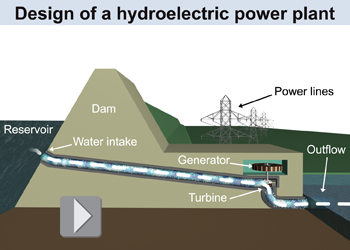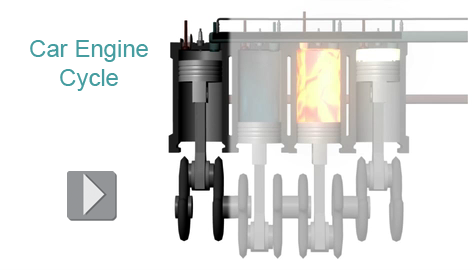|
 Energy technology, such as a power plant, does not create energy. A power plant converts energy in one form, such as the potential energy of elevated water, into another form, such as electrical energy. A hydroelectric power plant converts the gravitational potential energy of water in the reservoir into electrical energy that can be sent to your home. The hydroelectric plant’s reservoir of water is stored behind a dam so that there can be a larger vertical height (or head) between the reservoir and the turbines in the power plant.
Energy technology, such as a power plant, does not create energy. A power plant converts energy in one form, such as the potential energy of elevated water, into another form, such as electrical energy. A hydroelectric power plant converts the gravitational potential energy of water in the reservoir into electrical energy that can be sent to your home. The hydroelectric plant’s reservoir of water is stored behind a dam so that there can be a larger vertical height (or head) between the reservoir and the turbines in the power plant. 
|
The basic idea of the hydroelectric dam is that the water is allowed to drop a substantial distance, converting potential energy into kinetic energy. The kinetic energy of the water is then used to turn a propeller-like machine called a turbine. The turbine’s kinetic energy does work on an electric generator connected to the turbine by a metal shaft. The generator turns the work done into electrical energy. Hydroelectric power is clean, efficient, and stable. There are not enough places, however, that are geographically suited to large-scale dams. Approximately 6.4% of the electricity generated in the USA is from hydropower, which makes up 68% of all renewable energy generation. 
 |
Some notable examples are the Hoover Dam, built in the 1930s on the Colorado River at the border between Arizona and Nevada; the Aswan High Dam, built in the 1960s on the Upper Nile in Egypt; and the Three Gorges Dam, built in the 1990s and 2000s along the Yangtze River in China. The hydroelectric dam is an engineering and technological marvel that transforms potential energy into electricity to power our lives. Their construction can take many years and require thousands of workers. Some of the largest dams are even tourist attractions! 
|
The first successful internal combustion engine was created by the German inventor Nikolaus Otto in 1867. Otto’s engine is often called a “four-stroke” engine because a full operating cycle takes four strokes of the piston, two up and two down. Only one of the strokes produces power. 
|
 The cycle begins with a downward intake stroke—in which the piston pulls air and fuel into the cylinder. Next comes an upward compression stroke, where the piston compresses the air–gas mixture. When the gas is most compressed, the spark plug fires in the power stroke; the resulting internal explosion causes expansion of the gas that forces the piston downward. The last part of the cycle is the upward exhaust stroke, in which the piston expels the spent fuel and air mixture out of the engine (and then eventually out the car’s tailpipe).
The cycle begins with a downward intake stroke—in which the piston pulls air and fuel into the cylinder. Next comes an upward compression stroke, where the piston compresses the air–gas mixture. When the gas is most compressed, the spark plug fires in the power stroke; the resulting internal explosion causes expansion of the gas that forces the piston downward. The last part of the cycle is the upward exhaust stroke, in which the piston expels the spent fuel and air mixture out of the engine (and then eventually out the car’s tailpipe). 
|
The internal combustion engine is a marvelously compact and efficient technology. A device half the size of a person can produce the equivalent power of 200 large horses. Essentially, the engine converts chemical energy in gasoline into heat. The heat does work as the gas trapped inside the cylinder expands. The force produced by the moving piston in effect converts the heat energy into mechanical energy by turning a crankshaft that is ultimately connected to the wheels of a vehicle. 
|

